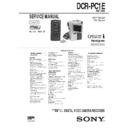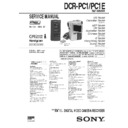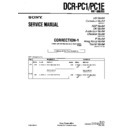Sony DCR-PC1E Service Manual ▷ View online
DCR-PC1E
RMT-809
AEP Model
UK Model
SERVICE MANUAL
DIGITAL VIDEO CAMERA RECORDER
MICROFILM
D200 MECHANISM
SPECIFICATIONS
Level 1
Ver 1.0 1998. 07
— 2 —
SAFETY-RELATED COMPONENT WARNING!!
COMPONENTS IDENTIFIED BY MARK
!
OR DOTTED LINE WITH
MARK
!
ON THE SCHEMATIC DIAGRAMS AND IN THE PARTS
LIST ARE CRITICAL TO SAFE OPERATION. REPLACE THESE
COMPONENTS WITH SONY PARTS WHOSE PART NUMBERS
APPEAR AS SHOWN IN THIS MANUAL OR IN SUPPLEMENTS
PUBLISHED BY SONY.
COMPONENTS WITH SONY PARTS WHOSE PART NUMBERS
APPEAR AS SHOWN IN THIS MANUAL OR IN SUPPLEMENTS
PUBLISHED BY SONY.
1.
Check the area of your repair for unsoldered or poorly-soldered
connections. Check the entire board surface for solder splashes
and bridges.
connections. Check the entire board surface for solder splashes
and bridges.
2.
Check the interboard wiring to ensure that no wires are
"pinched" or contact high-wattage resistors.
"pinched" or contact high-wattage resistors.
3.
Look for unauthorized replacement parts, particularly
transistors, that were installed during a previous repair. Point
them out to the customer and recommend their replacement.
transistors, that were installed during a previous repair. Point
them out to the customer and recommend their replacement.
4.
Look for parts which, through functioning, show obvious signs
of deterioration. Point them out to the customer and
recommend their replacement.
of deterioration. Point them out to the customer and
recommend their replacement.
5.
Check the B+ voltage to see it is at the values specified.
6.
Flexible Circuit Board Repairing
• Keep the temperature of the soldering iron around 270˚C
during repairing.
• Do not touch the soldering iron on the same conductor of the
circuit board (within 3 times).
• Be careful not to apply force on the conductor when soldering
or unsoldering.
SAFETY CHECK-OUT
After correcting the original service problem, perform the following
safety checks before releasing the set to the customer.
TABLE OF CONTENTS
SERVICE NOTE
1.
Power Supply During Repairs ············································ 3
2.
How to Take a Cassette Out When the Main Power Cannot
Be Turned On ····································································· 3
Be Turned On ····································································· 3
SELF-DIAGNOSIS FUNCTION
1.
Self-Diagnosis Function ····················································· 4
2.
Self-Diagnosis Display ······················································· 4
3.
Service Mode Display ························································ 4
3-1.
Display Method ·································································· 4
3-2.
Switching of Backup No. ··················································· 4
3-3.
End of Display ···································································· 4
4.
Self-Diagnosis Code Table ················································· 5
1.
MAIN PARTS
1.
Ornamental Parts ································································ 6
1-2.
Cabinet (L) Assembly, Cabinet (R) Assembly ··················· 7
1-3.
Cabinet (L) Assembly, EVF, MD Block Assembly ············ 8
1-4.
VC-210 Board, DC-111 Board, MF-40 Board ··················· 8
1-5.
Control Switch Block ························································· 9
1-6.
Cabinet (R) Assembly, PD-102 Board ····························· 10
1-7.
CD-203 Board ·································································· 11
1-8.
VF-125 Board ··································································· 11
2.
GENERAL
Before you begin
Using this manual ··································································· 12
Checking supplied accessories ··············································· 12
Checking supplied accessories ··············································· 12
Getting started
Charging and installing the battery pack ································ 13
Inserting a cassette ·································································· 13
Inserting a cassette ·································································· 13
Basic operations
Camera recording ···································································· 14
Hints for better shooting ························································· 16
Checking the recorded picture ················································ 17
Playing back a tape ································································· 17
Searching for the end of the picture ········································ 18
Hints for better shooting ························································· 16
Checking the recorded picture ················································ 17
Playing back a tape ································································· 17
Searching for the end of the picture ········································ 18
Advanced operations
Using alternative power sources ············································· 18
Changing the mode setting ····················································· 19
Photo recording ······································································· 20
Using the FADER function ····················································· 21
Using the wide mode function ················································ 22
Enjoying picture effect ···························································· 22
Superimposing a still picture on a moving picture ················· 22
Recording still pictures successively ······································ 23
Replacing a brighter portion of a still picture with a
moving picture ········································································ 23
Adding an incidental image to pictures ·································· 23
Using slow shutter ·································································· 24
Adding an old movie type atmosphere to pictures ················· 24
Shooting with backlighting ····················································· 24
Adjusting the exposure ··························································· 24
Adjusting the white balance ···················································· 25
Using the PROGRAM AE function ········································ 25
Focusing manually ·································································· 25
Releasing the STEADYSHOT function ································· 26
Superimposing a title ······························································ 26
Making a custom title ····························································· 27
Labeling a cassette ·································································· 28
Watching on a TV screen ························································ 28
Enjoying digital effect during playback ·································· 29
Searching the boundaries of recorded tape
with date - date search ···························································· 29
Searching the boundaries of recorded tape
with title - title search ····························································· 30
Searching for a photo - photo search/photo scan ···················· 30
Returning to a preregistered position ······································ 31
Displaying recording data - data code function ······················ 31
Editing onto another tape ························································ 32
Audio dubbing ········································································ 33
Changing the mode setting ····················································· 19
Photo recording ······································································· 20
Using the FADER function ····················································· 21
Using the wide mode function ················································ 22
Enjoying picture effect ···························································· 22
Superimposing a still picture on a moving picture ················· 22
Recording still pictures successively ······································ 23
Replacing a brighter portion of a still picture with a
moving picture ········································································ 23
Adding an incidental image to pictures ·································· 23
Using slow shutter ·································································· 24
Adding an old movie type atmosphere to pictures ················· 24
Shooting with backlighting ····················································· 24
Adjusting the exposure ··························································· 24
Adjusting the white balance ···················································· 25
Using the PROGRAM AE function ········································ 25
Focusing manually ·································································· 25
Releasing the STEADYSHOT function ································· 26
Superimposing a title ······························································ 26
Making a custom title ····························································· 27
Labeling a cassette ·································································· 28
Watching on a TV screen ························································ 28
Enjoying digital effect during playback ·································· 29
Searching the boundaries of recorded tape
with date - date search ···························································· 29
Searching the boundaries of recorded tape
with title - title search ····························································· 30
Searching for a photo - photo search/photo scan ···················· 30
Returning to a preregistered position ······································ 31
Displaying recording data - data code function ······················ 31
Editing onto another tape ························································ 32
Audio dubbing ········································································ 33
Additional information
Usable cassettes and playback modes ····································· 33
Resetting the date and time ····················································· 34
Simple setting of clock by time difference ····························· 35
Tips for using the battery pack ··············································· 35
Maintenance information and precautions ······························ 36
Using your camcorder abroad ················································· 37
Trouble check ········································································· 38
Self-diagnosis function ··························································· 39
Identifying the parts ································································ 39
Warning indicators ·································································· 42
Resetting the date and time ····················································· 34
Simple setting of clock by time difference ····························· 35
Tips for using the battery pack ··············································· 35
Maintenance information and precautions ······························ 36
Using your camcorder abroad ················································· 37
Trouble check ········································································· 38
Self-diagnosis function ··························································· 39
Identifying the parts ································································ 39
Warning indicators ·································································· 42
— 3 —
SERVICE NOTE
1.
POWER SUPPLY DURING REPAIRS
In this unit, about 10 seconds after power is supplied (4.2V) to the
battery terminal using the regulated power supply, the power is shut
off so that the unit cannot operate.
This following two methods are available to prevent this. Take note
of which to use during repairs.
battery terminal using the regulated power supply, the power is shut
off so that the unit cannot operate.
This following two methods are available to prevent this. Take note
of which to use during repairs.
Method 1.
Connect the servicing remote commander RM-95 (J-6082-053-B)
to the LANC jack, and set the remote commander switch to the
“ADJ” side.
to the LANC jack, and set the remote commander switch to the
“ADJ” side.
Method 2.
Use the AC power adaptor.
2.
HOW TO TAKE A CASSETTE OUT
WHEN THE MAIN POWER CANNOT
BE TURNED ON
WHEN THE MAIN POWER CANNOT
BE TURNED ON
Note:
To take a cassette out forcibly as follows when the main power
cannot be turned on, remove the cabinet (L) assembly. Apply +4.5
V power from an external power supply to the loading motor, as
shown below. Refer to sections 2-1 and 2-2 for the procedure to
remove the cabinet (L) assembly.
cannot be turned on, remove the cabinet (L) assembly. Apply +4.5
V power from an external power supply to the loading motor, as
shown below. Refer to sections 2-1 and 2-2 for the procedure to
remove the cabinet (L) assembly.
Procedure:
1)
1)
Disconnect the CN2504 of the MR-40 board.
2)
Apply +4.5 V directly to the loading motor as shown to drive
the loading motor that ejects a cassette.
the loading motor that ejects a cassette.
:unloading
:loading
Loading motor
— 4 —
SELF-DIAGNOSIS FUNCTION
1.
SELF-DIAGNOSIS FUNCTION
When problems occur while the unit is operating, the self-diagnosis
function starts working, and displays on the viewfinder or LCD
screen what to do. This function consists of two display; self-
diagnosis display and service mode display.
Details of the self-diagnosis functions are provided in the Instruction
manual.
function starts working, and displays on the viewfinder or LCD
screen what to do. This function consists of two display; self-
diagnosis display and service mode display.
Details of the self-diagnosis functions are provided in the Instruction
manual.
Note:
The self-diagnosis display data will be backed up by the coin-type lithium battery. When this coin-type lithium battery (CN2507 of MR-40 board)
is disconnected, the self-diagnosis data will be lost by initialization.
is disconnected, the self-diagnosis data will be lost by initialization.
2.
SELF-DIAGNOSIS DISPLAY
When problems occur while the unit is operating, the counter of the
viewfinder shows a 4-digit display consisting of an alphabet and
numbers, which blinks at 3.2 Hz. This 5-character display indicates
the “repaired by:”, “block” in which the problem occurred, and
“detailed code” of the problem.
viewfinder shows a 4-digit display consisting of an alphabet and
numbers, which blinks at 3.2 Hz. This 5-character display indicates
the “repaired by:”, “block” in which the problem occurred, and
“detailed code” of the problem.
3.
SERVICE MODE DISPLAY
The service mode display shows up to six self-diagnosis codes shown in the past.
3-1.
Display Method
While pressing the “STOP” key, set the switch from OFF to “CAMERA” or “VTR or PLAYER”, and continue pressing the “STOP” key for
10 seconds continuously. The service mode will be displayed, and the counter will show the backup No. and the 5-character self-diagnosis
codes.
10 seconds continuously. The service mode will be displayed, and the counter will show the backup No. and the 5-character self-diagnosis
codes.
3-2.
Switching of Backup No.
By rotating the control dial, past self-diagnosis codes will be shown in order. The backup No. in the [] indicates the order in which the
problem occurred. (If the number of problems which occurred is less than 6, only the number of problems which occurred will be shown.)
[1] : Occurred first time
problem occurred. (If the number of problems which occurred is less than 6, only the number of problems which occurred will be shown.)
[1] : Occurred first time
[4] : Occurred fourth time
[2] : Occurred second time
[5] : Occurred fifth time
[3] : Occurred third time
[6] : Occurred the last time
3-3.
End of Display
Turning OFF the power supply will end the service mode display.
Order of previous errors
Backup No.
self-diagnosis codes
C : 3 1 : 1 1
[3]
Lights up
Viewfinder or LCD screen
[3] C : 3 1 : 1 1
1 1
3 1
C
Repaired by:
Refer to page 5.
Self-diagnosis Code Table.
Self-diagnosis Code Table.
Indicates the appropriate
step to be taken.
E.g.
31 ....Reload the tape.
32 ....Turn on power again.
step to be taken.
E.g.
31 ....Reload the tape.
32 ....Turn on power again.
Block
Detailed Code
Blinks at 3.2Hz
C : Corrected by customer
H : Corrected by dealer
E : Corrected by service
H : Corrected by dealer
E : Corrected by service
engineer
Viewfinder or LCD screen
C : 3 1 : 1 1
Control dial



